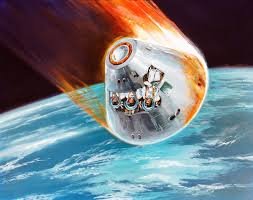Terminal Speed
claimed by cshimkus3
Main Idea
Mathematical Model
In Projectile Motion, we considered the motion of an object under the influence of a constant gravitational force [math]\displaystyle{ g = 9.8 m/s^2 }[/math], an approximation which is essentially accurate on the Earth's surface (the more accurate understanding, provided by Newton, may be found in Gravitational Force). However, we did not take into account a very important factor, because in everyday life, objects in motion do not stay in motion: this is because they are feeling the effects of air resistance (and, if they are in contact with other objects, friction). If, on the other hand, and object falls in a vacuum, it can be observed to have the same acceleration regardless of its mass or size. In the following video, a feather and a ball bearing are dropped inside a vacuum, and one may observe that they fall at exactly the same rate. (Click on the picture)
The friction due to air is a non-constant force on a falling object, and is determined by a number of factors. The force of air on a falling object is defined as follows:
[math]\displaystyle{ \vec{F}_{drag} = -\frac{1}{2} C \rho A v^2 \hat{v} }[/math]
Where [math]\displaystyle{ C }[/math] is the numerical drag coefficient which is dependent on the shape of the object, [math]\displaystyle{ \rho }[/math] is the density of air, [math]\displaystyle{ A }[/math] is the cross sectional area of the object, and [math]\displaystyle{ v }[/math] is its velocity. The vectors and sign enforce the correct direction of the force. Naturally, these coefficients vary greatly between a feather and a ball, and this is why in normal experience they fall at a substantially different rate:
One of the important features of this equation is the dependence upon the velocity of the object: since the force of air depends on the square of the velocity, while the force of gravity remains constant, the force of air resistance will increase until the two forces cancel each other out and the net force is zero. At this point, the acceleration of an object is zero and the object has reached terminal velocity. An object's terminal velocity is defined by:
[math]\displaystyle{ v_t = \sqrt{\frac{2mg}{C\rho A}} }[/math]
Computational Modelling
Using the same computational techniques discussed in Fundamentals of Iterative Prediction with Varying Force and utilized in Simple Harmonic Motion and Iterative Prediction of Spring-Mass System, it is simply necessary to define and input the newly defined force of air resistance. This is done so [here] using numpy, and may also be done with VPython.
Examples
Skydiver: Think of a free-falling skydiver. When he/she is falling with their arms and legs stretched out like a star, they will accelerate until he or she reaches their terminal velocity. Now, what would happen if the free-faller pulled in his/her arms and legs and leans forward so that their body is more parallel with their free-fall? From our definition of terminal velocity defined above, we know that this speed is inversely dependent on the surface area of the falling object. So, we can infer that the skydiver would speed up, because when he/she bring their arms and legs in, they decrease their surface area perpendicular to the fall and therefor increase their terminal velocity.

Heat of Spacecraft: Think of a spacecraft re-entering the Earth's atmosphere. How would the engineers designing that spacecraft need to determine the temperature that the space craft material needs to withstand. Well, these engineers could use the energy principle and the specific heat of the building material to do so. By calculating the terminal velocity, the initial potential and kinetic energy of the space craft when it enters the Earth's gravitational pull, and then graphing all the energy as at the space ship plummets to Earth's surface, these engineers can determine the heat this building material must be able to withstand.

Connectedness
- How is this topic connected to something that you are interested in?
I have always been interested in skydiving and this topic is a vital concept for the spot. Just as in the example above, the way a skydiver positions their body determines how fast they will fall. Although it may seem easy to reposition your body mid-air, at such high velocities it takes very slow calculated movements so that you do not start plummeting out of control.
- How is it connected to your major?
As a chemical engineer, I may encounter having to develop materials that will be used in free fall. If I am helping develop the metal coating for a spacecraft or vessel that will free fall to Earth's surface at high velocities, I will need to ensure that this material has an appropriate heat capacity to withstand the friction from the air.
- Is there an interesting industrial application?
Although this is not quite an industrial application, the concept of terminal velocity is very important for the military when they perform air drops. In a war zone, supplies may need to be delivered to civilians and military forces behind enemy lines. To do so, very careful calculations must be made based on the speed of the aircraft making the delivery, the sturdiness of the material the containers are made of, and when the parachutes should be deployed. If anything with the calculations is off, the packages may end up miles away from the target zone, or may be shot down if the parachute is deployed too early.
History
The study of free fall began many centuries ago by the experiments of Aristotle and Galileo. They both monitored the motion of falling objects and Aristotle noted that if a feather and a hammer are dropped from the same height, the hammer will reach the ground first. Galileo, however, noted that if the hammer and feather had similar shapes, they would reach the ground at approximately the same time. He hypothesized that in the absence of air resistance, all objects falling from the same height will reach the ground at the same time. Many centuries later, when it became possible for his theory to be tested in a vacuum, he was proved to be correct. At this point, physicists knew that it was air resistance and not mass that was the factor affecting the speed of a free fall. Further experiments were performed to determined the relationship between an objects shape and size and its terminal velocity. It was found that objects with a larger surface area perpendicular to free fall will be exposed to more air force than an object with a smaller surface areas. From these experiments and relationships, the equation for force due to air and terminal velocity were developed.
See also
Are there related topics or categories in this wiki resource for the curious reader to explore? How does this topic fit into that context?
Further reading
Galileo's Leaning Tower Experiment Materials under Extreme Loadings: Application to Penetration and Impact
Books, Articles or other print media on this topic
External links
The Physics Zone Britanica Online NASA
Internet resources on this topic
References
http://hyperphysics.phy-astr.gsu.edu/hbase/airfri2.html http://hypertextbook.com/facts/JianHuang.shtml http://www.space-propulsion.com/spacecraft-propulsion/showcase/atmospheric-re-entry-demonstrator.html https://perseshow.wordpress.com/2014/12/09/16-galileo-and-motion/


